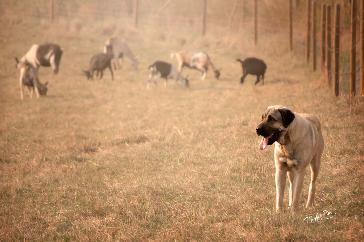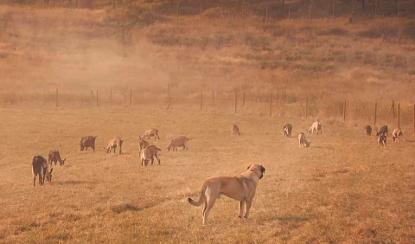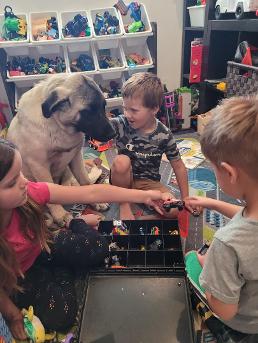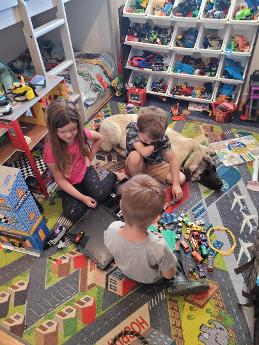About the Anatolian Shepherd Dog
pictures below from Mighty Pine Anatolians....true working dogs...not that mine aren't.
Mine just have an easier job.
Or maybe you prefer this kind of guardian
Temperament and Guarding Behavior
The temperament of the Anatolian Shepherd Dog is key to its ability to work. It is generally a serious dog that is devoted to its human companions. "Laid back" is a description I most often hear.
These dogs are strong-willed, independent and very territorial. If you have other dogs this will be the alpha dog!
When used as a flock guardian he is alert at night, when most predators would strike, and will create a perimeter around his territory that he patrols and marks each day at dawn and dusk. The Anatolian will find the highest viewing point and park himself there so that he can easily see the flock and anything going on around it. Stray animals (or people) that intrude on his territory are given warning with his deep bark, giving them ample time to leave. If they do not do so, the dog will give chase. Surprisingly, even after the Anatolian catches an intruder, he will often force him into submission and let him go. This is not a breed that goes looking for a fight. The temperament of an Anatolian on its own territory is very different from one away from home (like at a store, park or show). At home, he is very protective and will seriously bark at anyone out of the ordinary. If your mail person comes at 2 p.m. daily, the dog will recognize this as normal, but if they come at 11 a.m. one morning, the dog might alert you to the schedule change. Strangers are warned off of your property at any time of day by a dog that will bark, stare, and go up on its toes, with hackles raised. 'This is enough to make most people think twice about entering your property. He quickly learns what is normal daily activity by people in his area and will appear to lie around doing nothing.
If something appears in the outer perimeter, the dog will bark to announce that he has something under zone observation. If the potential threat commences toward the protected, the Anatolian will progress to a rapid alarm bark that may then progress to a threatening snarl-bark when something very threatening is about to be stopped. Occasionally, the Anatolian may attack silently.
Background of the Breed
Arid conditions, poor vegetation and rocky terrain, compelled the tough natives to adopt a primarily nomadic way of life. Family tribes were dependent upon raising large herds of sheep and goats for their subsistence. They would travel from region to region creating or overtaking settlements as they traveled. Sometimes many years or decades would pass before they returned to the original family settlements or villages. Aided with sticks and pebbles, the herds would be moved along by the shepherds to graze on hills and plains around the settlements. Protection of the hoof stock and the shepherds was the job for the large guard dogs that the shepherds brought with them. Çoban köpegi (Cho-bawn Ko-pey), Turkish for "shepherd's dog" was the term used to describe these working dogs. The dogs had to live peacefully among and protect the hoof stock with little or no special attention from the shepherds. The dogs stayed with the animals, night and day, sleeping in the thick snow of winter and walking for miles in the heat and dust of summer. Swift enough to race to the ends of a widely scattered grazing flock of several hundred head, the courageous guardian had to be large and strong enough to be able to best an interloper that dared stand its ground.
Survival of the fittest dogs, severe culling, and the breeding of the best working dogs all contributed to produce a rather uniform type of livestock guardian that is now Internationally recognized as the Anatolian Shepherd Dog. Because of the vast size of the country and great numbers of flocks, there have always been some regional differences in type, color, and family lines of the Çoban köpegi.
These dogs were almost never kept as pets, but dogs sometimes lived with their shepherds in the villages when the flocks were readied for sale or barter. Unmistakably capable as guarding dogs, they were also expected to be tolerant of the villagers and their children. In the villages, the intelligence and confidence of the dogs would be tested by their attitude toward normal daily activities. Dogs that were intolerant could have their throats slit. These complex interactions with their people helped to create a breed that has had stable temperament yet superb working ability.
Pups were severely culled; only one or two are kept to replace an older working dog. The ears were cut off the young working dogs so that all that remained were blunt stubs that could not be torn during a fight. Such injuries bleed profusely and were easily infected by heavy swarms of flies.
For dogs, there was little food to share. Goat milk and scraps might usually be given to raise a puppy to sufficient size and strength to stay with the herd. The dogs could not rely on the meager handouts of starch-based meal and other scraps. Dogs that survived were easy keepers that supplemented their diets by catching gophers or other small animals, never harming the charges entrusted to them.
These splendid dogs are still found wearing barbaric iron collar with long spikes to protect its throat from assailants and guarding livestock in the rural districts of Turkey. At the homestead, the Anatolian will announce the arrival of any visitors and will expect to be able to greet them with some formality. They are generally curious but aloof with guests. The dogs will usually go lay down after meeting with guests and will then watch them from a polite distance. If, after introduction, an unescorted guest wants to walk toward the owner's home, the Anatolian will block that person's path until the owner escorts the guest. If a houseguest wants to leave the house, a dog on the porch may not allow the person to move about freely until the owner joins the guest. Many Anatolian's will do this by giving a few barks to alert the owner, and then the dog will step across the person's path until the owner arrives.
The Anatolian is a bold, confident dog that does not become over stimulated easily. They are calm and observant of their surroundings. The Anatolian may not go looking for trouble, but he may not back down if challenged.
Aggression
Aggression in the Anatolian is generally limited to the lowest level that provides the desired response from the rival. They do not exist to hunt down and kill predators. They could not effectively protect the rest of their flock or territory if that were the case.
If the Anatolian is annoyed with something, he may snap his teeth into the air with an audible click. He may bark, growl, or draw his lips in an ominous silent threat.
Usually, the Anatolian will turn his head away from something that he does not wish to hurt, such as a family member or another pet, then he will getup and leave if the annoyance continues.
Anatolians spend most of the day dozing. They can go from apparent sleep to a dead run at 25-30 mph in seconds towards any threats to their charges.
We suggest obedience training your Anatolian to underscore your alpha status and so they learn basic commands that will be helpful in every day circumstances.
Since they nap a lot - they have small appetites. They are not big eaters needing only 1/2 again as much as a 60 lb house dog.
They deter predators by marking their territory and barking. They are not random barkers going on and on all day. Anatolian's learn what is "NORMAL" by observation. They will quietly watch all the normal comings and goings and will only bark at unusual things happening. Strange cars, animals, birds, people and noises will set them off to call an alert bark. They can learn to be quiet - though if there is a real threat - they will ignore your "suggestion" to be quiet and will do their JOB of protection.









